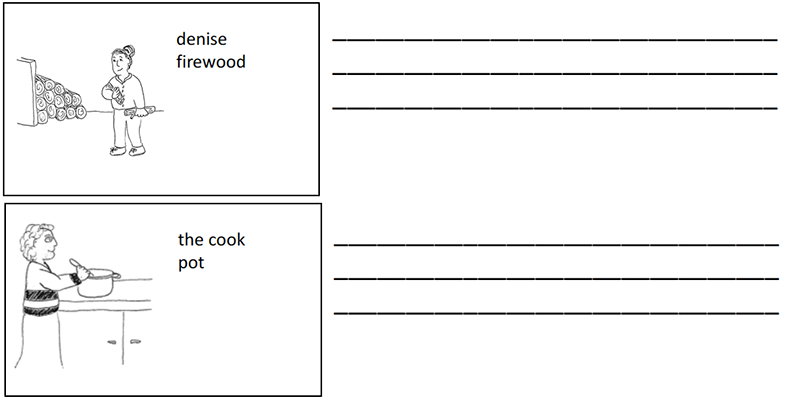1550 words | 8 minute read
Editor’s Note: This is the first of a two-part series on timed practice and writing fluency.
Once students have learned to compose sentences accurately (i.e., with minimal grammar, spelling, capitalization, and punctuation errors), the next step in advancing as a writer is to write fluently. Writing fluency is defined as writing with accuracy and speed (Johnson & Street, 2013). Students who do not write sentences fluently can find writing cognitively demanding because they spend much of their energy writing individual letters legibly and spelling words correctly (Gillespie & Graham, 2014).
These efforts can be a drain on students’ working memories. Consequently, they often do not spend time revising what they have written. However, when students can write sentences fluently, there is less demand on their working memories and they can devote their cognitive efforts to more complex writing tasks and skills such as writing paragraphs, essays, and using specific writing strategies (Graham, Gillespie, & McKeown, 2013).
Writing fluency activities, including the ones recommended here, can be used to supplement any writing instruction that is already occurring in the classroom. Fluency activities can be performed with students one-on-one or in small groups of 3-5 students.
Timed practice activities have been shown to improve students’ writing fluency (Datchuk, 2017). Timed practice can refer to any exercise in which students have a specified amount of time to write. For example, students may be instructed to write as many sentences as they can in 1 minute.
However, before teachers can implement timed practice with their students, they first need to decide how they will measure students’ writing, and then identify writing goals for their students.
Measuring Student Writing
Among the many writing measures available, correct writing sequences (CWS) and incorrect writing sequences (IWS) are sensitive measures for quickly assessing sentences (Hosp, Hosp, & Howell, 2016). These measures will be referred to throughout this post, so familiarity with CWS and IWS is important. For a detailed description of CWS and IWS, see the “Assessing Student Writing” guide with CWS and IWS (included in Supplemental Materials for Teachers below).
Goal Setting
Writing is a goal-directed behavior, and timed practice can become more effective when teachers include goals that students themselves monitor. Goal setting and progress monitoring have been shown to help students improve their writing skills (Evmenova et al., 2016; Koenig, Eckert, & Hier, 2016). Goals can come from several sources. Teachers using a commercially developed writing assessment may have access to established improvement norms. Alternatively, students can be guided to set their own goals based upon their prior performance (Hansen & Wills, 2014). For example, if a student consistently writes approximately 25 CWS in 1 minute, a teacher may consult with the student and determine a goal of 30 CWS would be appropriate. Once the student is able to meet and maintain her goal, the teacher can adjust the goal.
After establishing measures and goals, educators and students are ready to start using timed practice.
The Three Key Components of Timed Practice
Timed practice typically consists of three key components: (1) repeated writings, (2) immediate and corrective feedback, and (3) individualized goals with progress monitoring. We will look at the first component in this post. The “Sample Plan for Timed Writing Sessions” (see Supplemental Materials for Teachers below) provides an example for teachers to use which includes the three components.
(1) Repeated Writings
Repeated writings involve providing students with multiple, successive opportunities to practice writing within a time limit. For example, during a session students may participate in three consecutive 1-minute timings where they are asked to write as many sentences as possible in response to a writing prompt (described in more detail below). The key feature of repeated writings is students participating in several successive timings using an identical writing prompt within a single session. In each subsequent session, teachers would provide students a new writing prompt. Teachers can use their discretion when deciding how many timings to use in each session. The sample plan (see Supplemental Materials for Teachers below) provides a model for conducting three timings to a picture-word prompt.
There are many different styles of writing prompts, but all are designed to help students think of sentences. One such option is a traditional curriculum-based measurement of written expression (CBM-WE). These tools are usually simple in design: a single page with a story starter written at the top. A story starter is a brief sentence or two that sets up a scenario the writer can resolve. For example:
I was in the basement when I heard a noise. I turned around and . . .
Students can write the remainder of the story either below the prompt or on separate paper. Similarly, teachers can use a writing prompt that presents the student with a topic and specific directions for responding. For example:
Imagine you and a friend found a spaceship. The door opened and you looked inside. Write about what happened.
The administration of these types of CBM-WE prompts varies depending upon the type of story starter. Some CBM-WE prompts provide a think-time phase where students have a certain amount of time (e.g., 1 minute) to think about how they will respond to the story starter, followed by a specific amount of time (e.g., 1-3 minutes) to write their response (Powell-Smith & Shinn, 2004). For example, teachers might use the following directions:
Here is a story starter. It reads, “I was in the basement when I heard a noise. I turned around and . . .” I want you to write as many sentences to finish this story as you can. You will have 3 minutes. First, you will have 1 minute to think about what you want to write. Your think time begins now.
[Teacher sets the timer for 1 minute. 1 minute passes.]
Okay, pick up your pencil. You will have 3 minutes to write as many sentences as you can to finish the story. You may begin.
[Teacher sets the timer for 3 minutes. 3 minutes pass.]
Please put your pencils down.
Another option is for teachers to use a set of picture-word prompts. Picture-word prompts broadly refer to many different writing aids, but most depict an object (either a person or an animal) engaged in some sort of activity with a few accompanying words that describe the image. Rather than a single prompt, the set of prompts presents a collection of ten unique images, each with two words that help describe the image. To the right of the pictures and words is a space for students to write a sentence about each image. For example, consider these two from a set of 10 picture-word prompts:

Courtesy Professor Shawn Datchuk (shawndatchuk.com/sentence-practice/)
Teachers can introduce students to these picture-word prompts by describing the layout of the page and explaining to students how to use the images and words to write sentences. Then teachers can explicitly state the parameters of the timing, remind students of their goal, and allow the students time to look over the set of prompts and ask questions. For example, a teacher might begin the first timing by saying the following:
Here is a set of picture-word prompts. On the left-hand side, you can see a series of ten pictures. There are also words related to the pictures. I want you to write one sentence to go with each picture. You can use the words to help you decide what to write. Take a moment to look at the 10 pictures and related words.
[Allow time for students to review the prompts and then clarify any questions they have about the pictures or the words.]
Remember that your goal is to write 30 CWS during your best timing today. You will have one minute to write as many sentences as you can using these pictures. [Set the timer.] You may begin.
[Teacher starts the timer. 1 minute passes.]
Please put your pencils down.
If students need a more explicit introduction to the picture-word prompts, teachers may begin the session by modeling an example. The sample plan (see Supplemental Materials for Teachers below) provides guidance on how teachers can introduce and model picture-word prompts for their students and additional detail on how to carry out the activities.
This post introduced three components of timed practice that teachers can use to promote students’ sentence writing fluency, and covered the first component, repeated writings, in depth. Check back for the final post of this two-part series, which will cover the last two components of timed practice: immediate and corrective feedback and individualized goal setting and progress monitoring.
Supplemental Materials for Teachers
Sample Plan for Timed Writing Sessions
Introducing picture-word prompts for practicing writing fluency and modeling how to use them for one-on-one and small-group instruction. Also includes providing students with feedback and progress monitoring.
An introductory guide about using correct writing sequences (CWS) and incorrect writing sequences (IWS) as measures of student writing (and in this case, writing fluency).
Additional Resources
- Example writing prompts: These prompts from the Virginia Department of Education intended for Grade 5 can be used to help students write more during timed practice.
- Free picture-word prompts: The picture-word prompts available from UI College of Education Assistant Professor Dr. Shawn Datchuk are used in the blog post and can be used for timed practice activities to help students practice their writing skills.
References
Datchuk, S. M. (2017). A direct instruction and precision teaching intervention to improve sentence construction of middle school students with writing difficulties. Journal of Special Education, 51, 62-71. doi:10.1177/0022466916665588
Evmenova, A. S., Regan, K., Boykin, A., Good, K., Hughes, M., MacVittie, N., . . . Chirinos, D. (2016). Emphasizing planning for essay writing with a computer-based graphic organizer. Exceptional Children, 82, 170-191. doi:10.1177/0014402915591697
Gillespie, A., & Graham, S. (2014). A meta-analysis of writing interventions for students with learning disabilities. Exceptional Children, 80, 454-473. doi:10.1177/00014402914527238
Graham, S., Gillespie, A., & McKeown, D. (2013). Writing: Importance, development, and instruction. Reading & Writing, 26, 1-15. doi:10.1007/s11145-012-9395-2
Hansen, B. D., & Wills, H. P. (2014). The effects of goal setting, contingent reward, and instruction on writing skills. Journal of Applied Behavioral Analysis, 47, 171-175. doi:10.1002/jaba.92
Hosp, M. K., Hosp, J. L., & Howell, K. W. (2016). The ABC’s of CBM: A practical guide to curriculum-based measurement (2nd ed.). New York, NY: The Guilford Press.
Johnson, K. R., & Street, E. M. (2013). Response to intervention and precision teaching: Creating synergy in the classroom. New York: Guilford.
Koenig, E. A., Eckert, T. L., & Hier, B. O. (2016). Using performance feedback and goal setting to improve elementary students’ writing fluency: A randomized control trial. School Psychology Review, 45, 275-295. doi:10.17105/SPR45-3.275-295
Powell-Smith, K. A., & Shinn, M. R. (2004). Administration and scoring of written expression curriculum-based measurement (WE-CBM) for use in general outcome measurement. NCS Pearson. Retrieved from http://www.aimsweb.com/wp-content/uploads/Written-Expression-CBM-Manual.pdf
